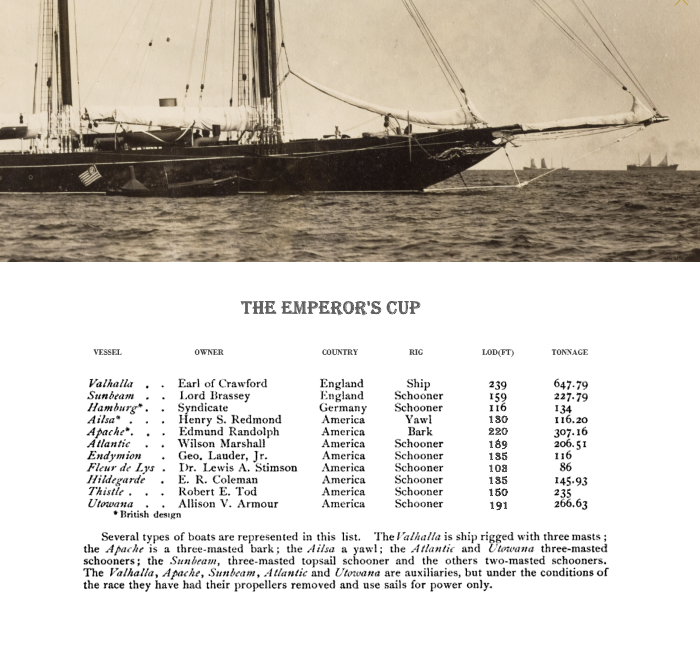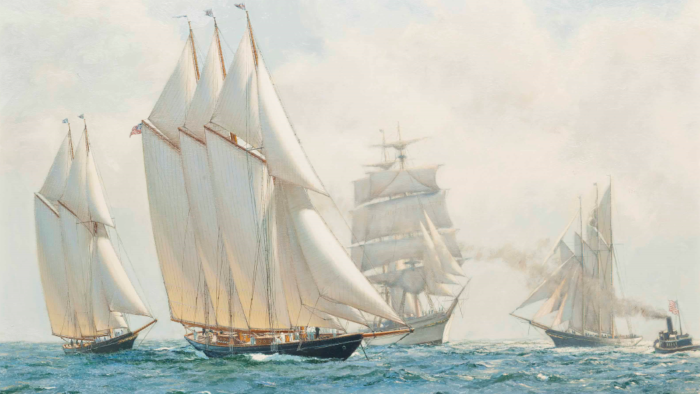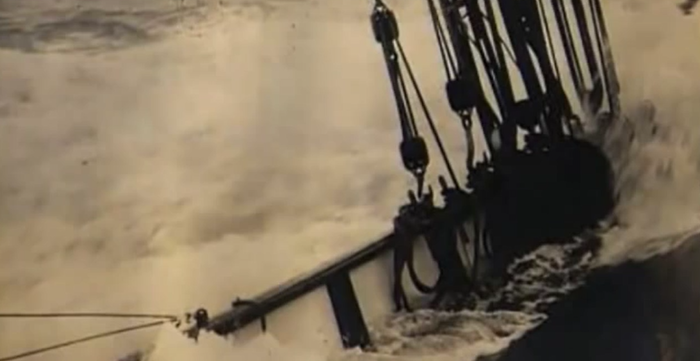The Last Great Race of Princes – May 18, 1905
[dropcap]”A[/dropcap]bout half-past six o’clock the war ship moved in and took up her position about two miles south of the Lizard Light, giving plenty of room between herself and the Atlantic to pass. The latter came on, boomed out with squaresail on her starboard side, every scrap of sail set, and drifted over the face of the sun, and the wind freshened up a bit. As the Atlantic drew nearer we could make out a big American ensign flying from her peak. With all her sail set, William Marshall’s beautiful auxiliary three- masted schooner crossed the outside line between the Lizard and the German dispatch vessel.”
“At the next moment every steam vessel within a radius of five miles, tugs, yachts, and launches began a strident concert with whistles. Captain Barr was seen leaning over the port rail of the yacht smoking a cigar. Asked what he thought of the Atlantic the captain said: “It amounts to this: I have got the best yacht afloat, next we had good leading breezes, then the crew worked nobly and you couldn’t find a better set of fellows.”
Introduction by James “Gordon” Bennet, Jr. – the New York Herald – (May 10, 1841 – May 14, 1918) was publisher of the New York Herald, founded by his father, James Gordon Bennett Sr. (1795–1872), who emigrated from Scotland. In 1866…on a bet, Gordon Bennet won the first trans-oceanic yacht race on his vessel Henrietta taking 13 days, 21 hours, 55 minutes to finish.
THE EMPEROR’S CUP WAS WON
Owner Wilson Marshall’s Story of How the Emperor’s Cup was Won
Outing Magazine (April-September 1905) AS TOLD TO ARTHUR GOODRICH, OUR REPRESENTATIVE IN ENGLAND
[dropcap]”I[/dropcap]N the busy days of preparation for this first contest for the Kaiser’s Cup, when the Atlantic was lying at anchor in the Horseshoe, I realized, in spite of my faith in my own yacht and in spite of my knowledge of the abilities of Captain Barr, his two assistants, Captain Pagel and Captain John Barr, and the crew, that such a race against such competitors was the most uncertain thing in the world. Weather, the course taken, luck, all these were potentialities to win the race, along with the boat’s capacity and the seamanship of those who sailed her. I did everything possible to make the Atlantic fit for victory, from the bottom inch of her hull to the tip of her top-masts, and then settled back to the feeling that we should do the best we could, and, whether we came in first or last, we should have a good cruise and some fine sport . Of course I wanted to win, and I wanted to see the Stars and Stripes go past the Lizard before any other flag. And when, after a day and a half’s camping on board waiting for the fog to lift, we went down to the starting-line off Sandy Hook on the morning of the 17th, there was a unanimous determination for victory on board the Atlantic, which counted, I think, during the days that followed. I think that my guests, six in number, Dr. F. B. Downs, Fred M. Hoyt, H. A. Bergmann, Morton W. Smith, L. B. Ostrander and C. B. Seeley, were all more confident of the result than I was.
“Eleven yachts are a large number to handle at a start and there was a good deal of jockeying and close work during the few moments before the signal, but Captain Barr put the Atlantic across the line quickly, with only the Hildegarde and the Ailsa ahead of us. There was some keen racing all that afternoon, the only real racing we saw. A fine east wind was blowing and we gradually crept up on the two yachts that were leading. In a little mora than an hour we crossed the Ailsa’s lee and passed her. Then we set out to overtake the Hildegarde, and shortly after four o’clock we took her wind and went by her, while, for the moment, she stood still.

“All this time, however, we had been watching the Hamburg. The German boat had been started directly after us, and throughout our chase of the Ailsa and the Hildegarde she held on splendidly. Soon it became a duel, for all the other boats dropped away or changed their course. The wind had freshened slightly, and we had seen the Hamburg’s jib-topsail split in two and cause her crew some anxious work. All this time we did not change sail, and the Atlantic was bounding along, well in the lead. “Then a strange thing happened. For no reason that I can understand the Hamburg, as night was coming on, began to draw up on us. There had been no change in the rigging and no noticeable change in the breeze. Both yachts were heeled over, the white water hissing along the scuppers and the spray flying gloriously. Until dark it was as pretty a race as one would see, but the Hamburg gained steadily, until at last she took our weather and passed us slowly. Why there was this sudden change in the footing of the two yachts I cannot explain, unless it was that our sails in stretching were not as yet doing their full work, or that the Hamburg felt the brisker wind more advantageously. But whatever the reason, she beat us in this little preliminary race, and when the darkness hid her from us she was still ahead of us, less than a half mile to the windward.
“By this time the breeze had slackened and it began to rain. Dense fog followed. The air was damp and chilly, and bit through heavy coats, but the yacht swung along under full sail. Mr. Benedict’s yacht, the Oneida, which had been following us, disappeared toward the south. And so, quickly, with the excitement of our little brush with the Hamburg past, came the realization of the long, uncertain task that lay before us, with no noise save the purring of unseen waters under our lee rail and the sounds of the few men of us aboard. We chatted for a time and then turned in for a good night’s rest.
“I confess that I had been amused by some of the reports in the papers, reports that told of a long night’s rest we all had had Tuesday night in preparation for the many sleepless nights before us. Sleepless nights in an ocean yacht race lasting two weeks would, of course, be fatal. Sleepy heads and tired bodies bungle, and the constant keenness of the men is as necessary as the set of the sails. I had shipped a large crew—we had about fifty men aboard; there were two captains to share the care with Captain Barr; and we all lived by shifts. Our men were as fresh at the Lizard as at Sandy Hook, with the possible exception of Captain Barr, upon whom, of course, rested the greatest responsibility in the handling of the Atlantic.
“Thursday morning, shortly after daybreak, the Oneida came by us and saluted, and when the weather cleared we could see, far away in the direction in which we had last seen the Hamburg the night before, the top-masts of a yacht rigged like the German boat. There was difference of opinion aboard as to whether this was or was not the Hamburg, but since the Hamburg’s log makes no mention of sighting us that morning, and since she would have seen the Atlantic more clearly than we should have seen her, it was undoubtedly some other boat of similar rig.
“From that time on the race, as far as we were concerned, resolved itself into an ordinary cruise, except, of course, for a certain taut discipline, a more machine-like regularity, an infinitely greater anxiety to obtain the greatest possible speed consistently, a nicer calculation to keep exactly the course we had planned before the yachts left the Horseshoe, and the keen interest in the daily reckoning, in the taking of which Captain Barr and Mr. Hoyt never varied enough to make cause for argument. These alone relieved the monotony of our days, for we never again saw one of the competing yachts, and we passed fewer steamships than one meets ordinarily on a liner. The Atlantic evidently took the lead that Wednesday night after the start, and was never headed.
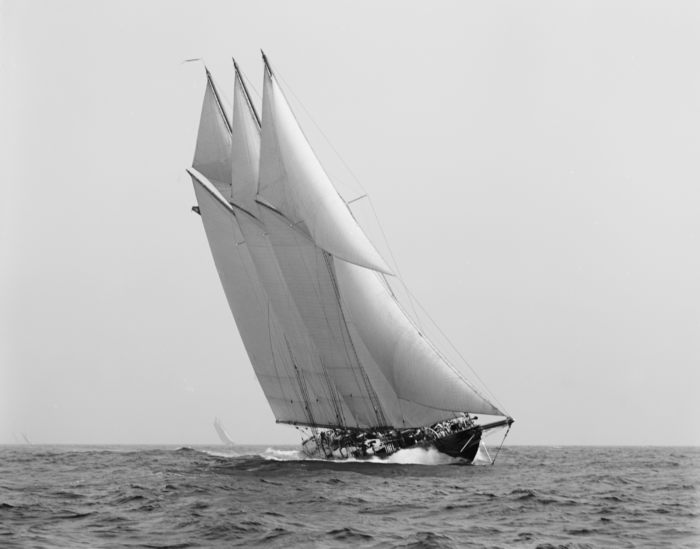
“All day Thursday we were on the lookout for the Hamburg, for my feeling before the race that the German boat was to be one of our most bothersome rivals had been accentuated by her showing Wednesday afternoon as we sailed out from the start. At noon we had come i65 miles of the journey (latitude 39 degrees 4o minutes, longitude 7o degrees 24 minutes, course south, 76 degrees east), and the Atlantic was doing her best with a light breeze and all sail set. Life aboard settled down to a routine. We ate and smoked and read and discussed over again the various yachts, their probable courses, their skippers and their capacities for speed. The course we had chosen for the Atlantic was not the shortest, for, it had seemed to us, the shortest route—that to the north—presented difficulties which more than equaled the gain in distance. We knew that the yachts had spread now to the various courses which they had marked out for themselves, that some were far to the north of us taking a shorter journey and that others were far to the south. Whether they were leading us was a matter which, we realized, would not be definitely known for many days. But we knew, from the speed the Atlantic was making under none too good conditions, that the yachts ahead of us, if there were any, were sailing a splendid race. And the real contest was still young.’
“That next day we added 222 miles, entirely without incident. The wind changed late Friday afternoon, but it remained light in quantity. The weather had cleared and we were in the Gulf Stream. The air was warm and balmy, and the night was glorious with bright moonlight on a gentle sea. All that evening while we watched the changing shine and shadow on the swaying water the Atlantic was proving her capacities as a light-weather boat. Indeed, she seemed to me to tiptoe across that endless field of moonshine, so silently and swiftly did she sail.
“The evening was only a forerunner of the day. Saturday morning was fine, with a splendid breeze from the west. The sun was hot and the temperature went up to summer heat during the morning. We were making good time under full sail, and a spinnaker. At noon we found that the day’s run had been 229 miles (latitude 2o degrees 45 minutes, longitude 60 degrees 38 minutes, course north, 82 degrees east).
“Before three o’clock the wind had veered to the southwest and we went faster without the spinnaker. Smoke appeared on the horizon before us, and two hours or more later we signaled the Minnitonka of the Atlantic Transport line, bound for New York. AH this time we were bowling along finely, but at half-past seven we saw black clouds racing up in the northwest and soon we began taking in topsails. Shortly after eight the squall reached us, driving a heavy rain across the decks. Everything was quickly made snug, however, and after some fitful blowing the wind died away. Up went the topsails again, so that we might make the most of the light air.
“Early Sunday morning a fine breeze sprang up out of the northwest, and the Atlantic began to make up time. All the morning under a leaden sky the wind continued fresh and steady, and at noon we reckoned a good day’s run, 27o miles (latitude 4i degrees 9 minutes, longitude 54 degrees 4o minutes, course north, 85 degrees east). The sun came out bright and warm before noon, and we set balloon staysails and No. 2 jib. All the afternoon the breeze continued, but it died away gradually toward nightfall. The calm continued all night and most of the day Monday, with vagrant light breezes now and then to lift hopes and dash them again. That morning we came close to a whale which spouted contempt for our leisurely gait and hurried away. The day’s run, reckoned Monday noon, was the poorest of our cruise—ii3 miles.
“Monday night came a welcome change. After a full day of loafing a fine wind from the south set us going again. At about nine o’clock the air suddenly grew cold, and the temperature of the water, quickly taken, registered 35 degrees. The lookout, shortly after, sighted a large iceberg,. with a dense haze hanging about its crest, about a mile to the north. Early Tuesday morning we passed close to another and larger berg which looked all of a third of a mile long, and which loomed up out of the water like a side street of downtown skyscrapers.
“The morning was bright and breezy, and the crew spent an hour or two recutting the topsails, which were badly out of shape from the wrenching blows they had had. ‘I he day’s run, reckoned Tuesday noon, was 243 miles, and we were still headed slightly into the north. In the afternoon the wind, which had been from the south, freshened and hauled gradually into the south-southeast. It was fine, steady going, the yacht heeled over and every sail working to its utmost. All night long the wind continued, growing stronger toward morning, and Wednesday morning we were racing along in a comparatively smooth sea and with the wind whistling merrily in the rigging. Great care was taken with the reckoning that noon, the many who took it uniting on a day’s run of 341 miles (latitude 44 degrees 57 minutes, longitude 39 degrees 5o minutes, course north, 65 degrees east), which is the new record for sailing-yachts, the previous record being that of the Dauntless, 328 miles. This, besides being a record, made up some of the ground we had lost during our bad day Monday, and increased our confidence for the final result.
“Late Wednesday afternoon, the breeze continuing to freshen, we reefed the spanker, and later took in both the spanker and the flying-jib. The water roughened rapidly and soon the Atlantic was plowing along with the spray spurting over her bow. By nightfall it was a very stiff breeze and the sea was running high. All night the blow lasted, and all day Thursday the fine sport continued. We were well reefed, but were carrying every ounce of sail that seemed safe. Thursday noon the day’s run stood 282 miles dead reckoning (latitude 46 degrees 33 minutes, longitude 33 degrees 3o minutes, course north, 7o degrees east). In the afternoon the sea and wind continued to increase, and we set trysails on the fore and mizzen, and had oil-bags over the bow. Time and again the waves washed the deck and foamed noisily in the scuppers. We were making good headway and took no unnecessary risks. There was no danger except of a fall on the slippery deck, and the panorama of the running sea was a great sight. It was fine sailing, the kind to make one glad one is alive. The Atlantic behaved as I have seen her behave before under similar conditions, riding the sea easily, never wrenching nor slapping. Her critics who call her merely a light-weather boat should have seen her that night and the next morning.
“All day Friday the blow continued, with high seas breaking into white crests all about us. We had oil-bags along the starboard side, and sailed under square sail and fore trysails. The day was an exhilarating one, the sea often came over.the side, and for 3 time we had the steersmen lashed to the wheel to make sure of their safety. The yacht shaped up splendidly, and Captain Barr handled her with all his accustomed skill. The day’s run, reckoned Friday noon, was 268 miles (latitude 45 degrees 58 minutes, longitude 26 degrees 48 minutes, course north, 71 degrees east).
“This fine, exciting bit of sailing lasted till the middle of the forenoon Saturday. Saturday was clear ami bright, and the wind and sea gradually diminished. Soon we put on more sail and began to shake out the reefs. The day’s run, Saturday noon, was 239 miles (latitude 48 degrees 56 minutes, longitude 2o degrees 53 minutes, course north, 76 degrees east), good going considering the sea and the small amount of canvas spread. Slowly the breeze went down and by nightfall it had veered around to our quarter and, though still steady, had not half the force of the early morning. We realized that we were well toward the end of our journey, and were keeping a sharp lookout for any of the other yachts. The Atlantic was in fine shape for a good race in if any of our rivals appeared. But we saw no vessel of any kind till Sunday afternoon.
“Sunday morning we had at first a good breeze from the southwest, but the wind was fitful, at times coming in brisk squalls that bent us well over and then dying aw:ay into lighter air. The day’s run was a good one, 313 miles (latitude 49 degrees, 52 minutes, longitude 13 degrees 2 minutes, course north, 8o degrees cast). Shortly after noon a steamer appeared behind us and passed us late in the afternoon with considerable difficulty, gaining little more than a mile an hour, for the Atlantic was making the most of the wind which had now steadied considerably and was sending us along at a smart pace.
“Monday morning we were up early, for we knew that we were fairly certain of crossing the line that day, and we were all ready for a final race to the Lizard. It was fine and clear and a very light breeze was blowing, but no yachts appeared. Soon we saw the Scilly Islands, but the wind died away to a dead calm and we drifted slowly, monotonously toward the goal. The day’s run at noon amounted to 282 miles. All that morning we were watching the westward horizon for sails, and it was not until an English vessel came out to us and told us that we were the first yacht in that the suspense was relieved. We did some cheering then, every one on board joining. We had every inch of sail spread, but the canvas shook in the idle air as we slowly drifted in. A little puff of wind helped us along occasionally, and at last convoyed by many friendly vessels we slipped past the Pfcil—the German cruiser which acted as stake-boat—in the brightness of the Lizard light and to the sound of a salute from one of the cruiser’s guns and the whistles of neighboring tugs and launches. We set off our signal lights and did some more cheering, and it was all over. It was a little after eight in the evening, Monday, May the 29th. We kept on up the Channel to Southampton and docked there early Wednesday morning.
“Nothing can be surprising about a long ocean race between yachts, but the most surprising thing to me, after seeing the Hamburg’s fine sailing qualities off Sandy Hook, was that we beat her by nearly a day. Her poorest day—142 miles—was, I notice, not as poor as our calm Monday when we covered only 113 miles.
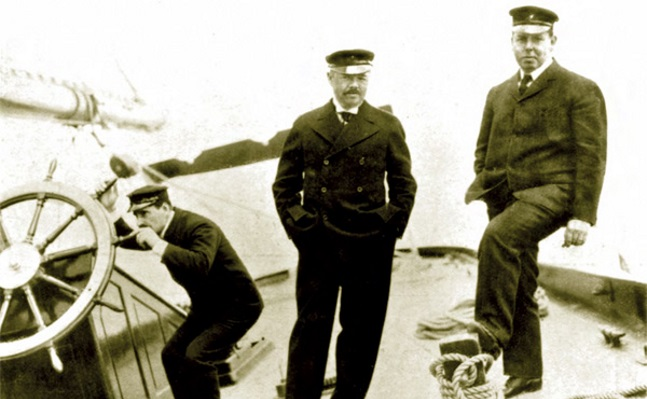
“Of course I am proud of the Atlantic. and I believe in her thoroughly. She met all kinds of weather on the way across, and made good speed out of everything except a flat calm. Captain Barr sailed her splendidly—as of course, every one expected he would—and his assistants and the crew worked with him like a machine. My guests were not only good company, but were helpful as well in time of need. And, aside from the race, we had some fine, exciting sport and an exceedingly pleasant cruise. Every one has been very kind and friendly over our victory, Americans, Englishmen and Germans alike.”
Thus the Atlantic finished first in 12 days 4 hours and 1 minute at an average speed of 1o.6 knots for the 3,o99 miles sailed. She beat the second boat, Hamburg, 22 hours 5 minutes; Valhalla, I day 22 hours 52 minutes; Endymion, 2 days 18 minutes; Ilildegarde, 2 days 52 minutes; Sunbeam, 2 days 2 hours 24 minutes; Flcur dc Lys, 2 days S hours 32 minutes; Ailsa, 2 days 7 hours 9 minutes; Utowana, 2 days 7 hours 5o minutes; Thistle, 2 days 15 hours 28 minutes.
It is instructive to compare Atlantic’s average speed with that of other famous across-ocean races. The following comparison is described by yachts name, build year and best average 24hr day speed and miles traveled.
Henrietta (1866) 9.36 – 280
Fleetwing (1866) 9.16 – 260
Vesta (1866) 9.14 – 277
Sappho (1869) 9.66 – 316
Coronet 1887 8.06 – 291
Dauntless (1887) 7.67 – 328
Vigilant (1894) 8.52 – 256
Yampa (1897) 8.00 – 283
Endymion 1900 9.66 – 298
Ingomar (1904) 8.25 – 260
Atlantic (1905) 10.31 – 341
Perhaps the most notable feature of the race, next to Atlantic’s good work, was the crossing of ten of the eleven owners on their own boats.
The Legend of Captain Charlie Bar – A 14 minute video including coverage of the Emperor’s Cup race, with some new and old pics mixed in.
Resources
- James “Gordon” Bennet, Jr.
- Outing Magazine (April-September 1905) Arthur Goodrich
- U.S. Naval Historical Center
- Charles Edwin Bolles
- NY Times for the 1905 article on the Kaiser’s Cup.
- Michael Redpath
- Anthony D. Blake (New Zealand, b.1951)
- Jones, Leslie, 1886-1967

